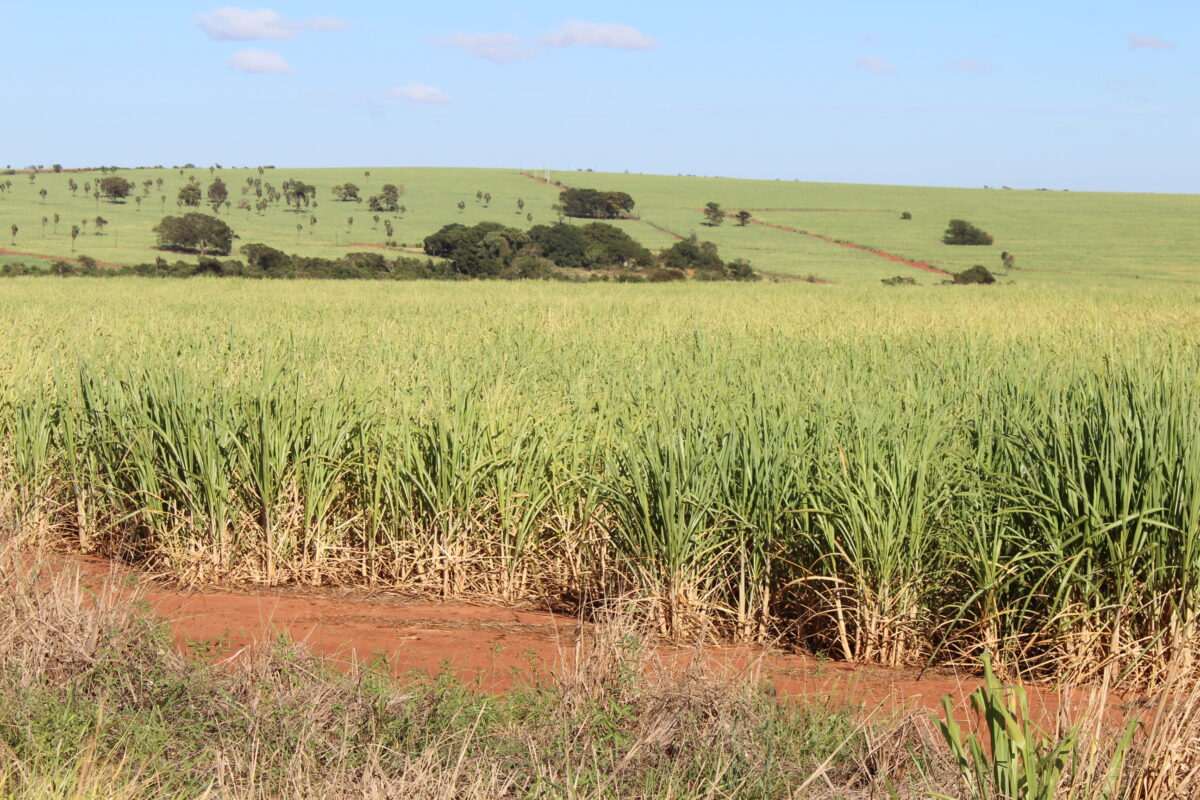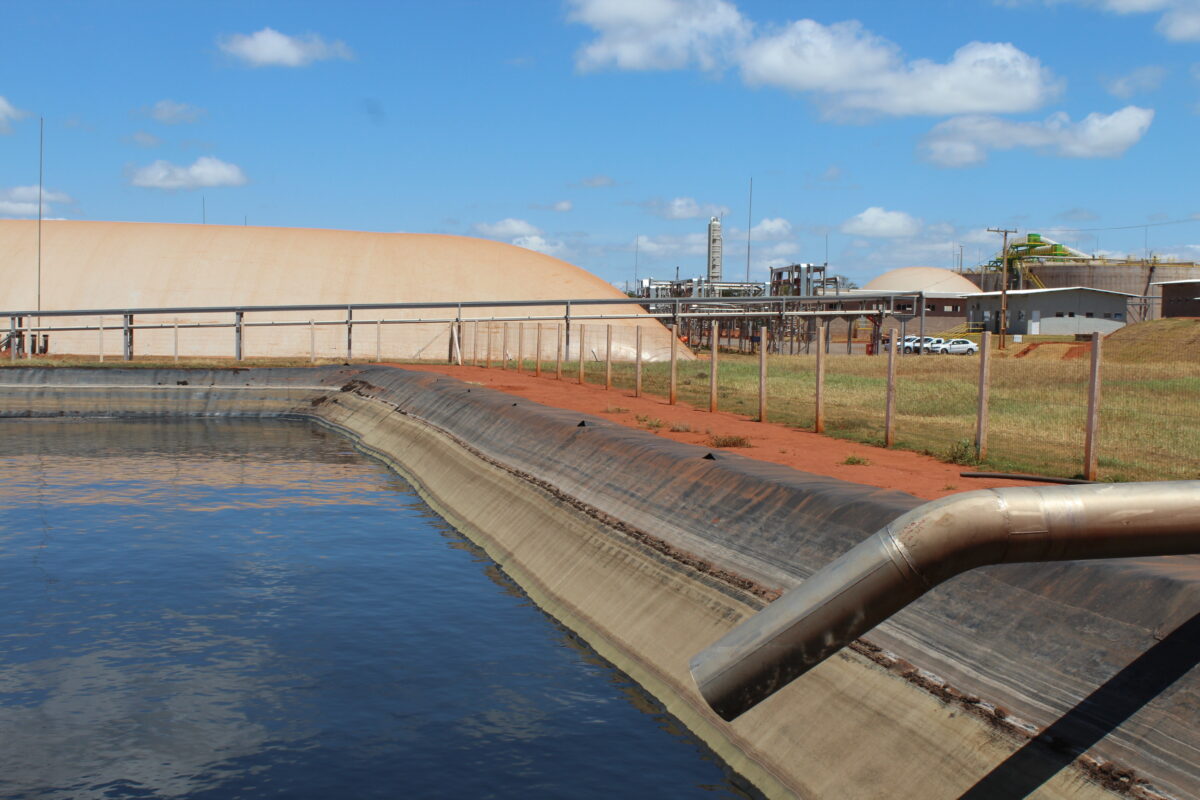Friday, April 19, 2024
News and Views from the Global South
Energy
Green Gas: Energy as a By-Product of Sugarcane in Brazil

The biodigester and part of the biogas plant of the Cocal company, surrounded by a sugarcane plantation on all sides, in the municipality of Narandiba, in the west of the southern Brazilian state of São Paulo, where sugarcane has replaced cattle ranching as the main economic activity. CREDIT: Mario Osava/IPS
- First came sugar. For four centuries, it was the main sugarcane product in Brazil. But since the 1970s sugarcane has grown and diversified as a source of energy: ethanol, electricity and biogas.
“Sugarcane is the green oil,” said André Alves da Silva, commercial and new products director of Cocal, as the company Comércio Indústria Canaã Açúcar e Álcool Ltda. is better known, which started large-scale production of biomethane, i.e. refined biogas, a renewable and clean equivalent of natural gas.
“We have a biofactory here,” he told IPS in an interview in the Cocal plant in Narandiba, a municipality located in the west of the southern state of São Paulo.
Referring to the plant whose scientific name is Saccharum officinarum as “sugarcane” has become obsolete in this region.
In addition to sugar and ethanol, electricity is generated from sugarcane bagasse, and biogas and other by-products are also created, such as biofertilizers, carbon dioxide gas and dried yeast, leftovers from alcohol fermentation, which, when processed, serve as protein-rich animal feed.
Biomethane in place of gas
The big novelty is biomethane, produced since June, as the starting point of a project that will bring gas to three closely grouped cities: Narandiba, Pirapozinho and Presidente Prudente, with a combined population of 264,000 people.
GasBrasiliano, a company of the state-owned oil conglomerate Petrobras, will be in charge of distribution and is building a 65-kilometer gas pipeline, which is scheduled to be inaugurated in June 2022.
“It is our first biomethane project, the first among many,” Alex Gasparetto, director-president of the distributor that holds the concession for piped gas in the west and north of São Paulo state, an area encompassing 375 municipalities and 9.2 million inhabitants, told IPS.
São Paulo, the richest and most populated state in Brazil, home to 46 million of the 214 million inhabitants of this enormous country, accounts for more than half of the national sugarcane production, in more than 150 agroindustrial sugar or ethanol plants next to sugarcane plantations, most of them in the GasBrasiliano concession area.

Sugarcane is the “green oil”, says André Alves da Silva, commercial and new products director of Cocal, an agroindustrial company located in Narandiba, in southern Brazil, which uses almost everything from sugarcane to produce electricity, biogas, biomethane, biofertilizers, yeast as animal feed and other gases, in addition to sugar and ethanol. CREDIT: Mario Osava/IPS
“The potential is huge, sugarcane biomethane can replace all the diesel and liquefied petroleum gas (for cooking) consumed in the state, a privileged situation,” said Alessandro Gardemann, president of the Brazilian Biogas Association (ABiogás).
“Cocal is a demonstration project, which goes from sugarcane cultivation to the final consumer with the supply of biomethane for the entire year,” he told IPS by telephone from Londrina, a city in the southern state of Paraná where his technology services company, Geo Biogas & Tech, which promoted biogas in the sugar-energy sector, is headquartered.
Solution for seasonal limitations
Geo’s technological contribution was decisive for the Cocal biomethane project to take off. It has long been known how to make biogas from vinasse, but this liquid residue from the ethanol (or alcohol) distillery can only be used during harvest season, generally from April to November.
The vinasse is bulky and smelly, impossible to store for many days in the ponds built to collect it before it is put into the horizontal biodigesters where the organic material is broken down in an anaerobic process that produces biogas.
To ensure a year-round supply, Geo adapted a German technology to incorporate into biodigestion another waste product, cachaça or filter cake, a dark sludge resulting from the processing of sugarcane juice to make sugar. Cachaça, for Brazilians, is the name for sugarcane brandy.
A treatment process that removes impurities and part of the moisture converts this waste, which used to be discarded, into raw material for biogas. It has “10 times more organic matter than vinasse,” which is why it is more productive, Eduardo Baptista, supervisor of industrial production at the Cocal biogas plant, told IPS.

A sea of sugarcane plantations flood Narandiba and its neighboring municipalities in the southern state of São Paulo, where the agroindustrial company Cocal grows it as the raw material for its biofactory for energy, fuels and agricultural inputs. CREDIT: Mario Osava/IPS
This innovation made it possible to overcome seasonality, as it is stored in four open-air tanks next to the two vertical biodigesters, specifically for the cachaça. “During the harvest, we use the vinasse and between harvests, the cachaça,” avoiding interruptions in the production of biomethane, explained Alves, the company’s commercial director.
A second factor in favor of the project, he said, was that there is local demand for gas that could not be met by the GasBrasiliano pipeline, whose nearest point is more than 100 km from Presidente Prudente, the main city in the region, with a population of 230,000.
Extending the existing network to this limited market would not be economically viable, but a 65-kilometer gas pipeline from Cocal is, said Gasparetto, GasBrasiliano’s director-president.
The third factor is environmental. With biomethane, Cocal seeks to reduce the greenhouse gases emitted in its ethanol production. Replacing diesel with green gas decarbonizes the activity by 95 percent. Additional reductions can be obtained with the new fuel in trucks and agricultural equipment, an alternative that is currently being tested.
In addition, the waste from which the biogas is extracted is converted into clean biofertilizers, which emit 75 percent less carbon than chemical fertilizers, said Cocal’s commercial director.
Lastly, the decision was also based on the dual use of biogas: electricity or biomethane.
“Having two options reduces the risks,” the proportions can be modified according to demand and prices, Alves said. Currently, 53 percent of the biogas is refined into biomethane and 47 percent is used for electricity generation.

The vinasse pond at the Cocal plant, in the Brazilian municipality of Narandiba, feeds the biodigesters that produce biogas, later purified and refined for use in electricity generation or conversion into biomethane, a renewable and clean fuel equivalent to natural gas. CREDIT: Mario Osava/IPS
Cocal has also been generating energy by burning bagasse since 2002. Today it can supply electricity to a city of 730,000 inhabitants, the company reports.
Social contributions
For all this energy production, Cocal has two industrial units, each with its own sugarcane fields around it. The first was installed in 1980 in Paraguaçu Paulista, 135 kilometers from Narandiba.
It employs a total of 5,500 workers in 22 municipalities and has 125,000 hectares planted to sugarcane, mostly on land leased under 20-year contracts, according to Alves. The harvest reached 8.7 million tons of cane last year.
Narandiba currently has about 6500 inhabitants, after 2000 arrived, attracted by the local operation of Cocal, inaugurated in 2008, said the town’s mayor, Itamar dos Santos Silva, who estimated at 600 the direct and indirect employees of the sugar and alcohol plant a year ago – almost 10 percent of the population.
The municipality, which had stagnated when cattle ranching dominated its economy in the last decades of the last century, has prospered again. “Sugarcane totally changed the social and economic situation in the region,” the mayor said in a meeting with IPS in his office.

Deposits of cachaça or filter cake, a residue from sugar production, proved advantageous in the generation of biogas at Cocal’s two plants in western São Paulo state, in southern Brazil. The reason is that the residue contains a lot of organic material and is available when there is a lack of vinasse between sugarcane harvests. CREDIT: Mario Osava/IPS
In addition to offering more jobs, Cocal pays even the lowest-earning employees double what a ranch worker used to earn, he said. With the rise in purchasing power, “every day a new house is built in Narandiba” and commerce and the demand for schools, health services and recreation has grown, Dos Santos Silva said.
Tax revenue also increased, but it lagged behind the immediate demands created by the influx of new residents, lamented the mayor, whose plans include attracting industry and stepping up the training of young people for the new supply of technical jobs in the sugarcane agro-industry.
Environmental sustainability was the main motive for Liane, a company that makes food products such as biscuits and pasta, to sign the first contract for the purchase of biomethane distributed by GasBrasiliano in Presidente Prudente.
Biomethane does not pollute like fossil fuels and probably has lower costs than “the natural gas that comes to us by truck from far away,” Mauricio Calvo, Liane’s industrial director, told IPS by telephone from the company’s headquarters.
Initially, biomethane will go to companies, fuel stations, shopping malls, hotels and large restaurants, i.e. large consumers.
The supply of piped gas to households remains a long-term goal, Gasparetto told IPS by telephone from GasBrasiliano’s headquarters in Araraquara, a town 280 kilometers from São Paulo.

 Print
Print



